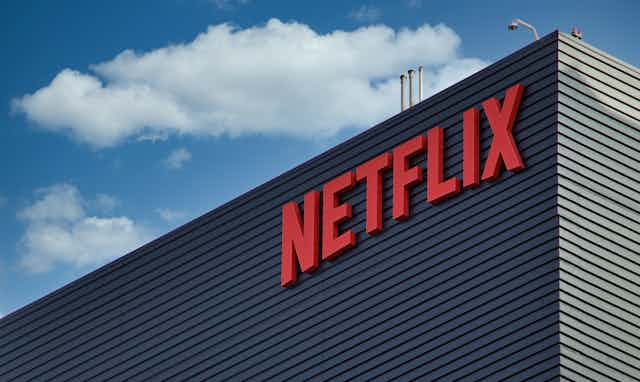Now that the Online Streaming Act has received royal assent, the legislation will require streaming services, like Netflix and Spotify, to promote Canadian content on their platforms.
It will also require the streamers to contribute funds to Canadian content production.
Exactly what that contribution framework will look like, and how Canadian and Indigenous content is defined, is now the focus of Canadian Radio-television and Telecommunications Commission (CRTC) public consultations slated to continue into 2024.

Understanding what Netflix’s role has been to-date in fostering equity and building capacity in the screen sector, and whether these investments provide necessary and effective support for emerging television and film creators, could help inform current decisions.
As my research with Kirsten Stevens of the University of Melbourne has found, the impact of Netflix’s investments on the production and distribution of domestic intellectual property is yet unclear.
Read more: How the Online Streaming Act will support Canadian content
2017 Netflix deal
In recent years, Netflix has been a key investor in programs that support the next generation of Canadian creators.
Netflix’s 2017 deal with the federal government saw the company commit to spending at least $525 million over five years in Canada’s screen sector. The deal included a talent development fund that led to a series of partnerships with film festivals and training organizations.
These talent programs target directors, producers and screenwriters from equity-deserving communities.
Netflix and festivals
The Netflix deal was part of the federal government’s strategy to boost investment in Canada’s creative industries while working on updated legislation for the digital age.
The influx of Netflix investment, including $25 million for “market development activities,” funded talent programs that were emerging at Canadian film festivals.
Before the Netflix deal, some programs focused on gender equity by supporting women in the screen industry, like Whistler Film Festival’s Women in Focus and TIFF’s Share Her Journey.
After the Netflix deal, talent development programs broadened the scope of equity beyond gender. Netflix also began directly funding under-represented groups: For example, the 2022 Doc Accelerator at Hot Docs supported by Netflix prioritized applicants who were Black, Indigenous, a person of colour, Francophone, deaf or living with a disability. This program included a paid mentorship opportunity.
Talent accelerator programs are designed to act as catalysts helping creators to reach the next stage in their career. For example, the imagineNATIVE Indigenous Screenwriting Intensive has offered support for writers to develop a script from concept to final draft as part of a Netflix partnership announced in 2019.
Women writers, directors and producers who were selected for the TIFF Talent Accelerator received fellowship funds to participate in “a customized year-long development experience.”
Lead sponsor
Some Netflix partnerships are outside the film festival sector, with organizations like the Canadian Film Centre, the Indigenous Screen Office and the Pacific Screenwriting Program.
Most of the market development partnerships are with film festivals, including: TIFF, Hot Docs, Rencontres internationales du documentaire de Montréal, imagineNATIVE Film + Media Arts Festival, Festival du nouveau cinéma, the Inside Out Film Festival (featuring 2SLGBTQ+ film) and the Banff World Media Festival. This last festival features the Netflix-Banff Diversity of Voices Initiative.
These partnerships have meant Netflix provides program funding, often as a lead sponsor (with prominent logo placement) or a title sponsor.
Equity, diversity and impact
Netflix’s highly visible engagement with Canadian film festivals might be seen as brand management. Charles H. Davis and Emilia Zboralska of Toronto Metropolitan University explain Netflix brands itself as “an emancipatory and innovative disruptor of the much-derided status quo.”
While Netflix’s deal in Canada might sound like a large investment, some critics noted it seemed to fall well short of the regulatory obligations met by the domestic cable industry: the investment was just a sliver of the streamer’s estimated 2017 content budget of US$6 billion.
Netflix has countered by stating it exceeded the agreement targets and continues to invest additional funds. Last October, the Hollywood Reporter noted the streaming giant celebrated “the milestone of 1000 creators completing Netflix-supported film training programs in Canada.”
It is important to measure the impact of these investments to figure out whether the talent accelerators provide an “on ramp” or just a leaky pipeline — meaning that supports to film and television creators aren’t, in fact, very effective for their career development.
A 2021 report produced by the Women in Film Television Coalition, the Deciding on Diversity report, raises the concept of risk theatrics to describe “superficial approaches to meeting diversity mandates” where “everybody wants to look like they’re doing the right thing.”
Questions of impact become increasingly pressing with the arrival of new legislation aimed at levelling the regulatory playing field. What is the fate of the talent development partnerships when Netflix’s obligations within the Canadian screen industry change under new legislation?
Changing talent development model
Much of the current focus of industry discussion has been on revamping the definition of Canadian content. The Canadian Media Producers Association also raised concerns about language relating to the use of Canadian creative talent having the potential to create a “two-tier system where foreign streamers are held to a lower standard.”
However, the Netflix deal points to the need to take a broader perspective about support for the industry ecosystem — in this case, how film and television artists develop their skills and know-how. These investments have played a role in changing talent development models in Canada.
More research is needed on the impact of the $25 million market development fund. While the deal wasn’t perfect, some promising investments were made. It is worth taking a closer look at how it has impacted the next generation of television and film creators in Canada.
To get a better sense of this, we need to understand the effects on both equity and intellectual property. Are Canadian and Indigenous creators getting to tell their own stories? And are these stories being bought?
The future of Canadian storytelling is about more than just a giant pot of money for content.

